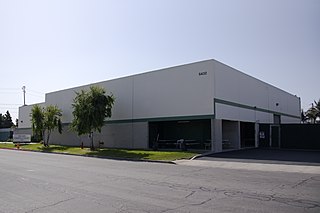
Zenith Data Systems Corporation (ZDS) was an American computer systems manufacturing company active from 1979 to 1996. It was originally a division of the Zenith Radio Company, after they had purchased the Heath Company and, by extension, their Heathkit line of electronic kits and kit microcomputers, from Schlumberger in October 1979. ZDS originally operated from Heath's own headquarters in St. Joseph, Michigan. By the time Zenith acquired Heathkit, their H8 kit computer already had an installed fanbase of scientific engineers and computing enthusiasts. ZDS' first offerings were merely preassembled versions of existing Heathkit computers, but within a few years, the company began selling bespoke systems, including the Z-100, which was a hybrid Z80- and 8088-based computer capable of running both CP/M and MS-DOS.

Mylex Corporation was an American computer company active from 1983 to 1999. The company mainly produced peripherals and expansion cards for personal computers—chiefly the IBM Personal Computer—for the bulk of its existence, although it also produced complete motherboards. In the mid-1990s the company focused on designing and manufacturing RAID controllers, eventually cornering 75 percent of the RAID controller market. In 1999, the company was acquired by and made a subsidiary of IBM for approximately $240 million. In 2002, IBM sold their Mylex division to LSI Logic for an undisclosed amount.
Celerity Computing, Inc., was a publicly traded vendor of Unix-based minisupercomputers based in San Diego, California. Celerity Computing was founded in May 1983 by Steve Vallender, Nick Aneshansley and Andrew McCroklin. All were former employees of NCR Corporation.
Crystal Semiconductor Corporation was an American computer company based in Austin, Texas, and active from 1984 to the early 2000s. Founded by Michael J. Callahan and James H. Clardy, the company originally specialized in the design and manufacture of silicon for mixed-signal integrated circuits, namely digital-to-analog (DAC) and analog-to-digital (ADC) converters. After being acquired by Cirrus Logic of San Jose, California, in 1991 for about $59 million, the company became a dominant player in the personal computer sound chip market.
North Star Computers Inc. was an American computer company based in Berkeley, California existing between June 1976 and 1989. Originally a mail order business for IMSAI computers, it soon developed into a major player in the early microcomputer market, becoming first known for their low-cost floppy disk system for S-100 bus machines, and later for their own S-100 bus computers running either the CP/M operating system or North Star's own proprietary operating system, NSDOS. North Star BASIC was a common dialect of the popular BASIC programming language. They later expanded their lineup with dual-CPU machines able to run MS-DOS, and a server version running either DOS or Novell NetWare.

Canon Computer Systems, Inc. (CCSI), sometimes shortened to Canon Computer, was an American subsidiary of Canon Inc. formed in 1992 to develop and market the parent company's personal computers and workstations. The subsidiary also assumed the responsibility of marketing Canon's printers and photocopiers, which were formerly sold by other Canon divisions. It went defunct in January 2001.

Librex Computer Systems Inc. was a short-lived American subsidiary of the Nippon Steel Corporation that manufactured notebook computers from 1990 to 1992. Librex had roots in Nippon Steel's Electronics and Information Systems Division (EISD) back in Japan, which starting in 1986 had formed joint ventures with several high-profile American computer companies. Librex was Nippon Steel EISD's first venture in the United States; it also set up Nippon Steel Computer PLC in the United Kingdom to sell identical products. The company's notebooks received praise in the technology press, but a fierce price war in the market for laptops in the early 1990s combined with dwindling profit margins compelled Nippon Steel to dissolve Librex in 1993.
Decision Data Computer Corporation, later Decision Industries Corporation and Decision Data Inc., was an American computer hardware company founded in 1969 and based in Horsham, Pennsylvania.
Timeworks, Inc., later Timeworks International, Inc., was a private American software publisher active from 1982 to 1994 and based in Chicago, Illinois. The company primarily sold entry-level productivity software, as well as advanced desktop publishing applications and video games. They are perhaps best known for Publisher, their flagship desktop publishing application. In 1993, they were acquired by Megalode Resources, Inc., of Burlington, Ontario, who operated the company until 1994.
Teleram Communications Corporation was a pioneering American computer company that manufactured the first commercially successful portable computers in the mid-1970s. Based in Mamaroneck, New York, Teleram was founded by Charles J. Satuloff in 1973.
Cipher Data Products, Inc., was an American computer company based in San Diego, California, and active from 1968 to 1992. The company was once a leading manufacturer of magnetic-tape data drives and media for minicomputers, becoming a pioneer in tape streamer technology in the early 1980s. In the late 1980s, they also briefly manufactured WORM optical discs, through a joint venture with 3M. In 1990, they were acquired by Archive Corporation for $120 million.
Avant-Garde Computing, Inc. was a publicly traded American software and computer hardware company active from 1978 to 1990 and based in Mount Laurel, New Jersey. It was most well known for its Net/Command, Net/Adviser, Net/Alert, and Net/Guard suite of network management, monitoring, and security products. The company was acquired by Boole & Babbage in 1990 after a five-year string of losses.
Pansophic Systems, Inc., or simply Pansophic, was a major American software company active from 1969 to 1991 and based in the Chicago metropolitan area. A pioneering software firm, it was among the first wave of independent software vendors in the late 1960s. Initially a supplier of source code and information management software for IBM mainframe computers with their flagship products Panvalet and Easytrieve, the company soon expanded into the minicomputer and personal computer markets, supplying application packages for many differing fields. The company was acquired by and absorbed into Computer Associates in October 1991 for nearly $300 million.

Advanced Digital Corporation (ADC) was a privately owned American computer company based in California, active from the 1980s to the 1990s. The company was founded by 1980 by a group of engineers, in order to market their single-user and multi-user expansion cards and peripherals for S-100–based computers.

Mountain Computer, Inc. was a privately held American computer peripheral manufacturer active as an independent company from 1977 to 1988. In its early years, the company chiefly developed products for the Apple II, including sound synthesizers, samplers, and hard disk and tape drives. Mountain also produced floppy disk duplicators for enterprise use. In the mid-1980s Mountain pivoted to focusing on products for the IBM Personal Computer and compatibles. In late 1988, the company was acquired by Nakamichi.
Micronics Computers, Inc. was an American computer company active from 1986 to 1998 that manufactured complete systems, motherboards, and peripherals. Based in the San Francisco Bay Area, Micronics was one of the largest domestic motherboard manufacturers in the United States in the 1990s. After acquiring Orchid Technology in 1994, the company entered the market for multimedia products, such as graphics adapters and sound cards. In 1998, Micronics was acquired by Diamond Multimedia.
Reference Software International, Inc. (RSI), was an American software developer active from 1985 to 1993 and based in Albuquerque, New Mexico, and San Francisco, California. The company released several productivity and reference software packages during their lifespan, including the highly popular Grammatik grammar checker, for IBM PCs and compatibles running DOS. The company was acquired by WordPerfect Corporation in 1993.
Lee Data Corporation was an American computer company based in Eden Prairie, Minnesota, and active as a hardware company from 1979 to 1990. It was principally founded by John M. Lee and John Roy to sell data terminal systems compatible with the IBM 3270. It found success going into the mid-1980s, with its offerings praised for their innovations and lower prices compared to IBM's 3270 line, but began faltering in the 1980s when IBM themselves began adopting such innovations.






